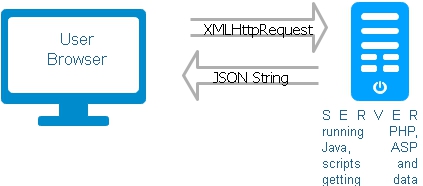XMLHttp Request object for Ajax
 The XMLHttpRequest object is a JavaScript API that allows us to make HTTP requests from a web browser, enabling us to communicate with a server and retrieve data without having to refresh the entire page.
The XMLHttpRequest object is a JavaScript API that allows us to make HTTP requests from a web browser, enabling us to communicate with a server and retrieve data without having to refresh the entire page.It's commonly used for implementing Ajax (Asynchronous JavaScript and XML) functionality, where we can update parts of a web page without requiring a full page reload.
An agent
This XMLHttp object is an agent between our application at client side and our programming code at server end. It sends data and collects the return data from the server.Browser support
Now we understood that creation of this XMLHttp request is an issue with the browser of the user ( or client ). So the user browser must able to create this XMLHttp object. Unfortunately the old browsers doesn't support this and can't create XMLHttp object. So we have to find out first this object is created or not. If the browser fails to create the object then we must give error message saying about the browser issue.Even if the browser are capable of creating our XMLHttp request they differ in the way they create it. FireFox create the object in a different way than Internet Explorer ( IE ). So based on this we will develop the code and note that we can use this same set of code ( to create the XMLHttp object ) in all pages where we will be using Ajax.
We will try with first trying with a simple request like this
if (typeof XMLHttpRequest != "undefined") Now let us write the function to initialize the XMLHttp Request object
function developXMLHttp() {
if (typeof XMLHttpRequest != "undefined") {
return new XMLHttpRequest();
} else if (window.ActiveXObject) {
var aVersions = [ "MSXML2.XMLHttp.5.0",
"MSXML2.XMLHttp.4.0","MSXML2.XMLHttp.3.0",
"MSXML2.XMLHttp","Microsoft.XMLHttp"
];
for (var x = 0; x < aVersions.length; x++) {
try {
var p2XmlHttp = new ActiveXObject(aVersions[x]);
return p2XmlHttp;
} catch (oError) {
//Do nothing
}
}
}
throw new Error("Error..XMLHttp object could be created.");
}function my_form(){
var myxml=developXMLHttp();
document.write(typeof(myxml));
}
window.onload=my_form();<html>
<head>
<title>(Type a title for your page here)</title>
</head>
<body >
<script>
function developXMLHttp() {
if (typeof XMLHttpRequest != "undefined") {
return new XMLHttpRequest();
} else if (window.ActiveXObject) {
var aVersions = [ "MSXML2.XMLHttp.5.0",
"MSXML2.XMLHttp.4.0","MSXML2.XMLHttp.3.0",
"MSXML2.XMLHttp","Microsoft.XMLHttp"
];
for (var x = 0; x < aVersions.length; x++) {
try {
var p2XmlHttp = new ActiveXObject(aVersions[x]);
return p2XmlHttp;
} catch (oError) {
//Do nothing
}
}
}
throw new Error("Error..XMLHttp object could be created.");
}
function my_form(){
var myxml=developXMLHttp();
document.write(typeof(myxml)+' This is the type of the object');
}
window.onload=my_form();
</script>
</body>
</html>Ajax Json XML

Subhendu Mohapatra
Author
🎥 Join me live on YouTubePassionate about coding and teaching, I publish practical tutorials on PHP, Python, JavaScript, SQL, and web development. My goal is to make learning simple, engaging, and project‑oriented with real examples and source code.
Subscribe to our YouTube Channel here
This article is written by plus2net.com team.
https://www.plus2net.com

